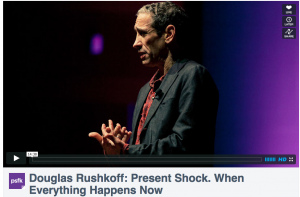THEME #3 FROM 7 PART POST SERIES EXPLORING THE EVOLUTION OF BRAND STORIES & THEMES
Great brand stories, not unlike human stories, can inspire vibrant conversation, sustained interest and engagement – especially within social communities. But only to the degree to which there is meaningful and mutual interest. Think about the ways we come to understand a person? Our innate social instincts strive to find common points of connection, understand context, and interpret their behavior. In other words, we synthesize what we learn and observe in order to better understand and connect. Contrast this approach to what happens in business when a brand attempts to connect with people. Ironically, the default response is to break down through analysis. Strip down into simplistic demographic terms, and segment in order to shape what is known. This process of re-interpretation is meant to simplify information – but in the long run it produces a distant and simplistic understanding of the customer. The difference of generalizing insight/information vs. pursuing meaningful customer “intelligence,” is not only a difference in philosophy and methodology. More importantly it is proving to be a significant business disadvantage.
“Everything should be made as simple as possible, but not simpler.” – Einstein
Limited Learning
We analyze and segment both in daily life as well as business. Doing so helps us feel in control, or at least establish some level of comfort in thinking so. In business, the use of evaluation filters such as demographics is typically used to guide the corporate understanding of the customer. Filters such as gender, income, size of house hold, etc., is typically used to help simplify data and objectify the way the customer is defined and understood internally. But how does this practice help brands to become more relevant in peoples’ lives? Sadly, it does not since it tends to oversimplify that which is meant to be complex in nature – people!
As social networks grow and measurement becomes more sophisticated, categorization filters such as demographics or simplistic approaches to groupings will become less useful for two reasons:
1) The reference point is based on past, out dated mass media success metrics (see my prior post regarding “Mass Media Push”) versus the reality of how digital/social integrates and influences daily life and behavior
2) The same information once deemed a strategic advantage is now available to all through online tools. There is no competitive edge to be gained if everyone is working through the same lens and defining customers in the same way
Defying Human Nature
It is in our human nature to analyze and segment. This process allows us to define and “manage” what might otherwise seem to be too massive, complex, or abstract to understand or communicate to others. Analysis offers a constructive “how to” process for studying the unknown. The theory being that if you do not understand – just study it long enough and dissect it down to a level that is useful or manageable. This approach is ideal when trying to deconstruct in order to re-build i.e. engineering or technology. But when it relates to people and the psychology of relationships, we need to re-define what is truly important to understand – not only that which is familiar, quantifiable or controllable. It is unfortunate that instead of investing the time and budget into better understanding the real-time context of relationships, behavior, influence and sentiment – business places greater value on understanding statistical probability and future likelihood.
Douglas Rushkoff, Media Theorist and the bestselling author of Present Shock: When Everything Happens Now, gave a brilliant talk at last month’s Pivot Conference in NYC and at PSFK (see below video) earlier this year. In his latest book he points out the major disconnect in business whereby Chronos (time) and Kairos (timing) produce a distorted reality of value. I strongly encourage you to watch his video talk below as he presents a compelling case for why business must invent new models of time and more accurate and meaningful ways to define value.
Insight vs. Intelligence
Having insight does not mean that you are informed. Furthermore, having more information does not mean that the ultimate application will be meaningful or relevant.
According to Wikipedia, the term “Intelligence” (derives from the Latin verb intelligere.) and since medieval times has meant “understanding.” Gathering insight information/data for the purposes of simplifying undermines our ability to truly understand. Market intelligence can only be achieved through a deeper understanding of the customer, the community drivers, behaviors and shared interests.
Social Science Lens
Instead of defining what we observe according to filters that relate to what is familiar in business, we should explore more ways to apply human-centered evaluation models and principles into business.
Take for example the Social Sciences. These are the academic disciplines that study the human aspects of society. Unlike arts and humanities, the social science utilizes both quantitative and qualitative methods of research and study.
The main social sciences include:
- Environmental studies
- Anthropology
- Communication
- Criminology
- Culture Studies
- Economics
- Education
- History
- Human Geography
- International Relations
- Linguistics
- Law
- Political Science
- Psychology
- Social Psychology
- Sociology
- Social Work
Today, there is already progressive customer research going on that involves principles of psychology, communication and linguistics.
But how might the application of other social sciences, i.e. Human Geography, that is the study of relationship across space and place, strengthen our understanding of the customer within context of his/her community?
Or how might a business better understand customer behavior change if evaluated from an anthropological lens?
The opportunities of developing a deeper understanding of the customer is limitless. By opening minds to human-centered philosophies of learning and observation, not only can business/brands enrich their understanding of their customers. But in the process unearth more accurate models of evaluation and more competitive ways to connect business/brands to people.
by Anneliza Humlen of SocialVoice LLC. / @ADHumlen
**Special thanks to highersights for use of Listen,Understand photo
Related post recommendations
• Humanizing Storytelling Principle #2 – From Mass Media Push to Engaging Relationships
• Humanizing Storytelling Principle #1 – From Corporate Size & Stats to the People Within
• 7 Ways to Humanize Storytelling for Business & Brands

